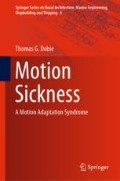Abstract
It is very appealing to try to predict susceptibility to motion sickness. Very many before me and no doubt many after, will pursue this goal. As you will see, my experiences have been very disappointing. I spent many years evaluating motion sickness history questionnaires and the seemingly predictive test of cupulometry—all to no avail. The more time I spend with people who suffer from chronic motion sickness, the more intrigued I am by their stories. These stories frequently seem illogical in terms of apparently widely different responses to stimuli that seem to be very similar. Suffice to say that in our laboratory we are frequently surprised by the responses of individuals. Those with a seemingly “bad” history often do better on our motion devices than others whose history seems less severe. We still have a lot to learn.
Access this chapter
Tax calculation will be finalised at checkout
Purchases are for personal use only
References
Ambler RK, Guedry FE (1965) The validity of a brief vestibular disorientation test in screening pilot trainees. NAMI-947, Joint Report US NAMI & NASA, Naval Aerospace Medical Institute, Pensacola, FL
Ambler RK, Guedry FE (1970) Reliability and validity of the brief vestibular disorientation test compared under 10-RPM and 15-RPM conditions. NAMRL-115, US Naval Aeromedical Research Laboratory, Pensacola, FL
Aschan G (1954) Response to rotatory stimuli in fighter pilots. Acta Otolaryngologica 116(suppl):24–31
Aschan G, Nylen CO, Stahle J, Wersall R (1952) The rotation test: cupulometric data from 320 normals. Acta Otolaryngol 42:451–459
Bárány R (1908) Die modernen untersuchungsmethoden des vestibularapparates und ihre praktische bedeutung. Med Klin 4:1903–1905
Benson AJ (1968) Postrotational sensation and nystagmus as indicants of semicircular canal function. In: Third symposium on the role of the vestibular organs in space exploration. Naval Aerospace Medical Institute, Naval Aerospace Medical Center, Pensacola, FL, 24–26 Jan 1967. NASA SP 152, pp 421–432
Benson AJ, Goorney AB, Reason JT (1966) The effect of instructions upon post-rotational sensations and nystagmus. Acta Otolaryngol 62:442
Birren JE, Fisher MB (1947) Susceptibility to seasickness: a questionnaire approach. J Appl Physiol 31:288–297
Bles W, de Jong HAA, Oosterveld WJ (1984) Prediction of seasickness susceptibility. In: Motion sickness: mechanisms, prediction, prevention and treatment. AGARD conference proceedings No. 372, North Atlantic Treaty Organization Advisory Group for Aerospace Research and Development, vol 27. Neuilly-sur-Seine, France, pp 1–6
Brown AC (1874) On the sense of rotation and the anatomy and physiology of the semicircular canals of the internal ear. J Anat Physiol 8:327–331
Collins WE, Lentz JM (1977) Some psychological correlates of motion sickness susceptibility. Aviat Space Environ Med 48(7):587–594
De Wit G (1953) Seasickness (motion sickness). A labyrinthological study. Acta Otolaryngologica 108(suppl):7–56
Dobie TG (1965) Motion sickness during flying training. In: AGARD conference proceedings No. 2, North Atlantic Treaty Organization Advisory Group for Aerospace Research and Development. Neuilly-sur-Seine, France, p 23
Dobie TG (1974) Airsickness in Aircrew. AGARDOGRAPH No. 177, North Atlantic Treaty Organization Advisory Group for Aerospace Research and Development. Neuilly-sur-Seine, France
Dobie TG (1980) An evaluation of the characteristics of repeat cupulograms and their relationship to the subject’s flying experience and motion sickness susceptibility. In: Proceedings of the annual scientific meeting of the Aerospace Medical Association. Aerospace Medical Association, Washington, D.C., pp 183–184
Dobie TG (1981) The characteristics of multiple repeat cupulograms and their relationship to flying experience, history of motion sickness and subsequent susceptibility to airsickness during flying training. In: Proceedings of the annual scientific meeting of the Aerospace Medical Association. Aerospace Medical Association, Washington, D.C., pp 201–202
Graybiel A, Wood CD, Miller EF II, Cramer DB (1968) Diagnostic criteria for grading the severity of acute motion sickness. Aerosp Med 39:453–455
Hardacre LE, Kennedy RS (1965) Some issues in the development of a motion sickness questionnaire for flight students. NSAM-916, US School of Aviation Medicine, Pensacola, FL
Hulk J, Jongkees LBW (1948) The turning test with small regulable stimuli. II. The normal cupulogram. J Laryngol Otol 62:70–75
Hutchins CW, Kennedy RS (1965) The relationship between past history of motion sickness and attrition from flight training. NSAM-932. US Naval School of Aviation Medicine, Pensacola, FL
Kennedy RS, Dunlap WP, Fowlkes JE (1990) Prediction of motion sickness susceptibility. In: Crampton GH (ed) Motion and space sickness. CRC Press Inc., Boca Raton, FL, pp 179–215
Lentz JM (1984) Laboratory tests of motion sickness susceptibility. In: Motion sickness: mechanisms, prediction, prevention and treatment. AGARD conference proceedings No. 372, North Atlantic Treaty Organization Advisory Group for Aerospace Research and Development, vol 29. Neuilly-sur-Seine, France, pp 1–9
Miller EF, Graybiel A (1969) A standardized laboratory means of determining susceptibility to Coriolis (motion) sickness. NAMI-1058, Naval Aerospace Medical Center, Pensacola, FL
Miller EF, Graybiel A (1970a) A provocative test for grading susceptibility to motion sickness yielding a single numerical score. Acta Oto-laryngologica 5(274)
Miller EF, Graybiel A (1970b) Motion sickness produced by head movement as a function of rotational velocity. Aerosp Med 41:1180–1184
Money KE (1970) Motion sickness. Physiol Rev 50:1–38
Morton G, Cipriani A, McEachern D (1947) Mechanism of motion sickness. Arch Neurol Psychiatry. 57:58–70
Reschke MF (1990) Reliability of provocative tests of motion sickness susceptibility. In: Crampton GH (ed) Motion and space sickness. CRC Press Inc., Boca Raton, FL
Turner M, Griffin MJ (1995) Motion sickness incidence during a round-the-world yacht race. Aviat Space Environ Med 66:849–856
van Egmond AAJ, Groen JJ, Jongkees LBW (1948) The turning test with small regulable stimuli. J Laryngol Otol 62:63–69
Author information
Authors and Affiliations
Corresponding author
Rights and permissions
Copyright information
© 2019 Springer Nature Switzerland AG
About this chapter
Cite this chapter
Dobie, T.G. (2019). Prediction of Susceptibility to Motion Sickness. In: Motion Sickness. Springer Series on Naval Architecture, Marine Engineering, Shipbuilding and Shipping, vol 6. Springer, Cham. https://doi.org/10.1007/978-3-319-97493-4_8
Download citation
DOI: https://doi.org/10.1007/978-3-319-97493-4_8
Published:
Publisher Name: Springer, Cham
Print ISBN: 978-3-319-97492-7
Online ISBN: 978-3-319-97493-4
eBook Packages: EngineeringEngineering (R0)

